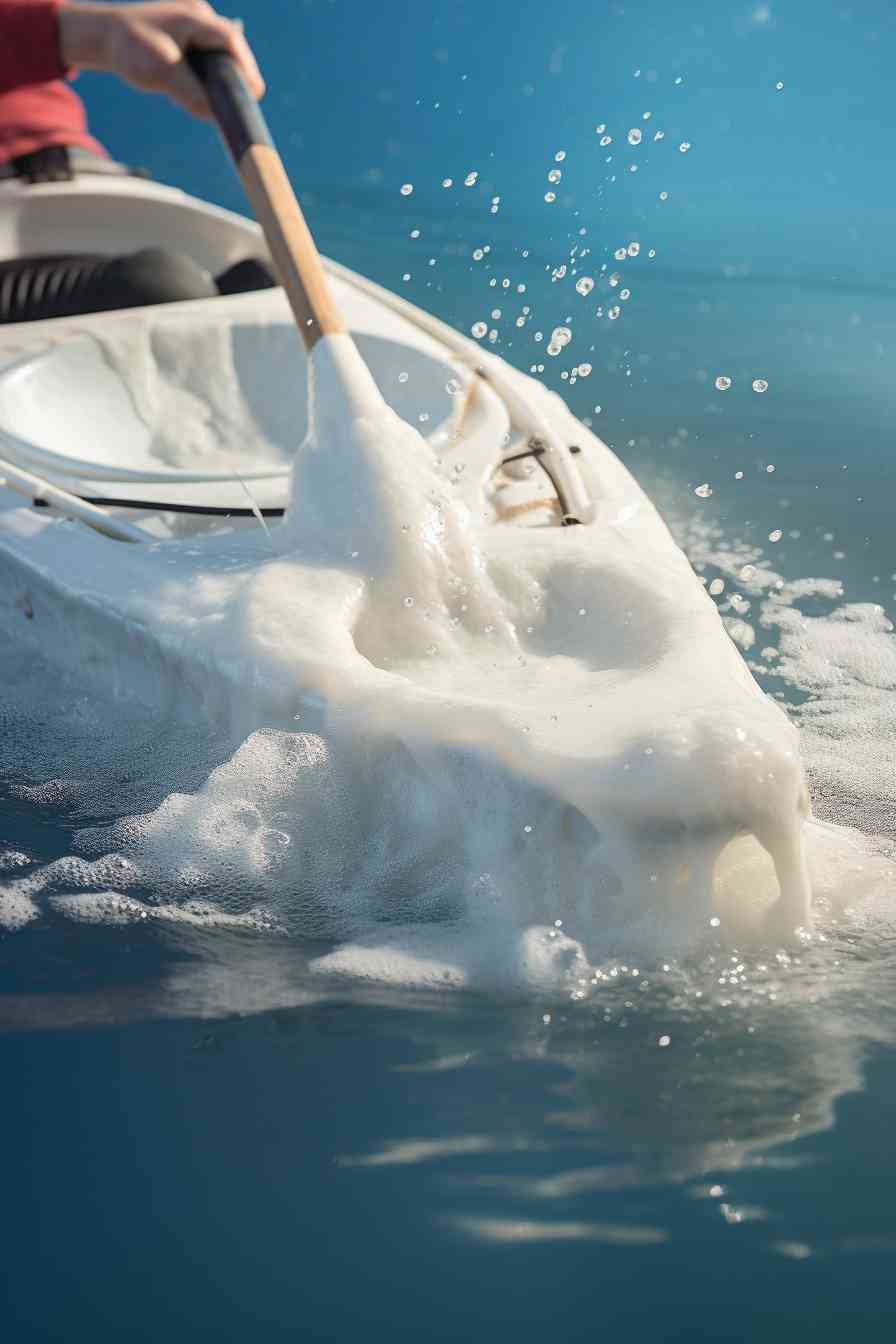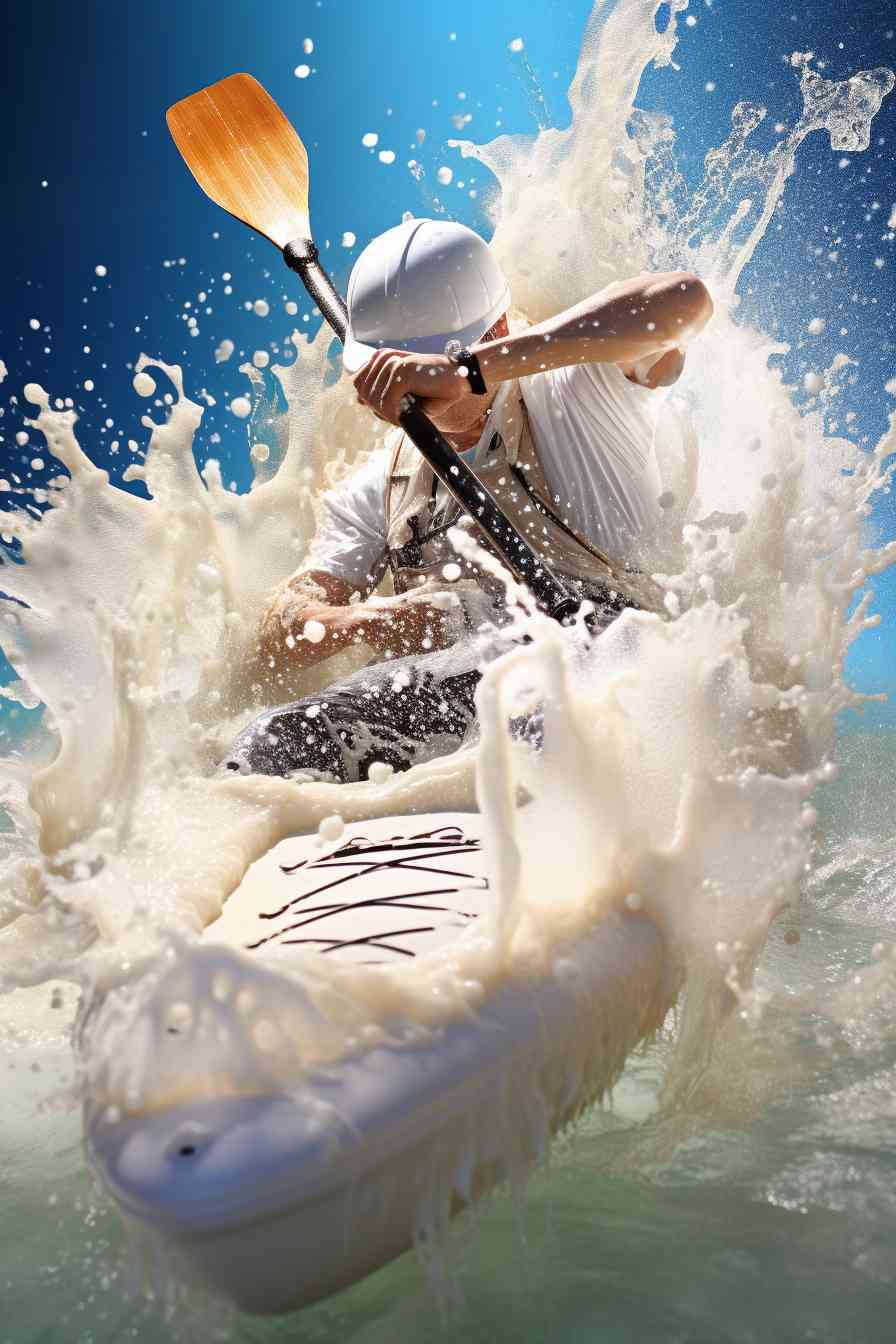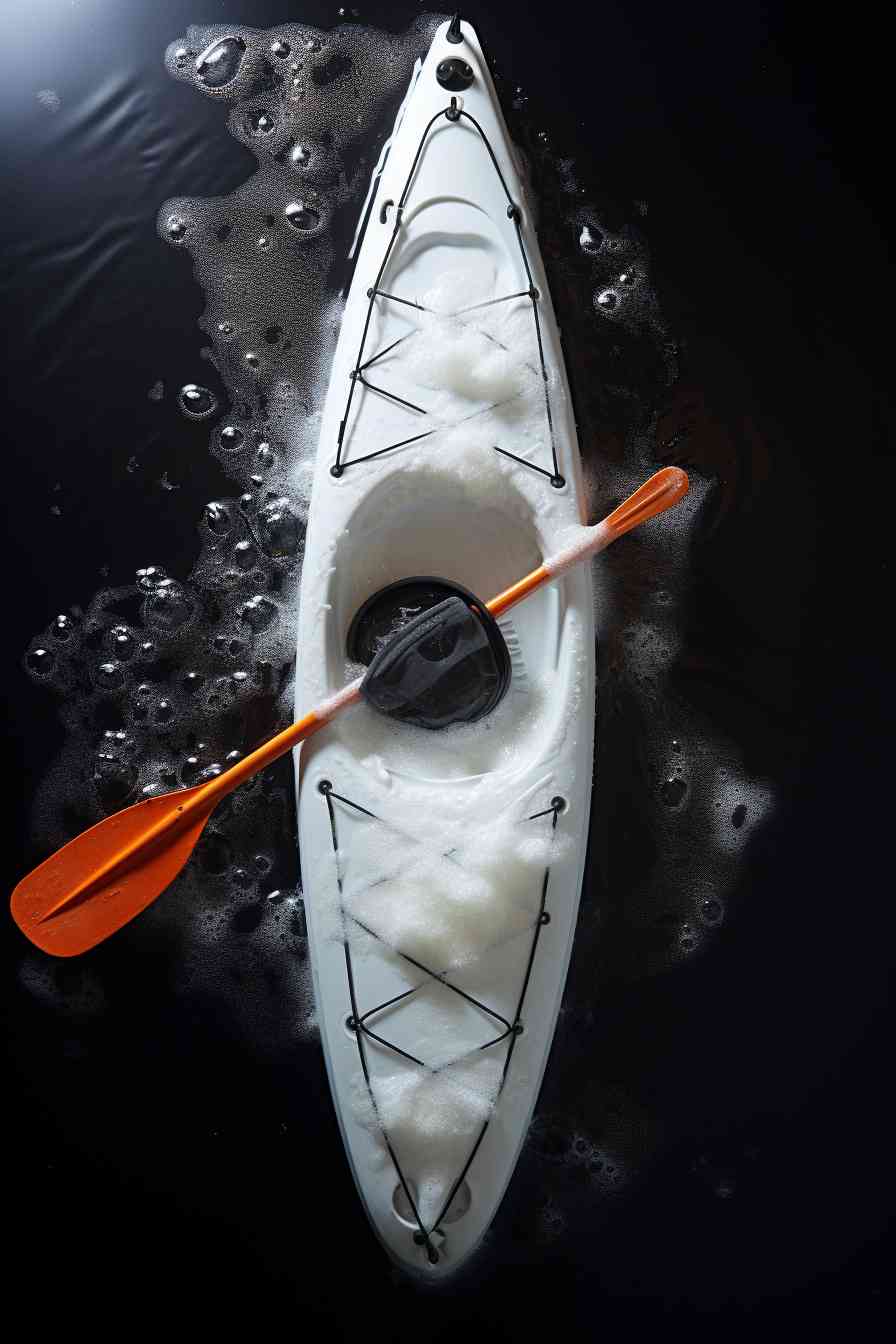Intro: How To Clean A Kayak

Well, hello there, my thrill-seeking compatriots! There’s absolutely nothing like gliding across the water in your slick kayak, taking in nature’s marvelous sights. But let’s face it, maintaining that kayak’s shine isn’t always a cake walk, is it? Fear not—I’m here to guide you through the process on how to clean a kayak.
First thing’s first, you’re going to need the right tools. We’re talking a mild detergent, sponge, hose, and a soft scrub brush, if necessary. Start by hosing down your kayak to remove the looser dirt and grime. You’d be amazed how much junk a simple hosing can wash away—it’s like a quick rinse for dishes before they go into the dishwasher.
After the pre-rinsing, apply some mild detergent on the stubborn spots and scrub lightly with your sponge. Remember, use the scrub brush only when you have to! We don’t want none of that unwanted scratching. For those pesky stains, coating them with a bit of baking soda before scrubbing might just do the trick. It’s a little known secret that works wonders, I’m telling you!
After all’s scrubbed and clean, hose the kayak down again until the suds are gone—kinda like rinsing out your mouth after brushing, ya know? Leave the kayak out to dry naturally or—if you’re in a rush—give it a wipe with a towel. And voila- you’ve got a clean, shiny kayak ready for your next exciting adventure!
So, that’s it. Seems simple enough, right? Yes, it does take a bit of elbow grease, but after all, doesn’t your trusty kayak deserve a little TLC? Keep it clean and it’ll keep you afloat to take on all of your water-bound adventures!
What Is The Best Thing To Clean A Kayak With?

Alright, let’s dive straight into this: the best thing to clean your kayak with. Before we start, I should tell you, I’m a firm believer that a clean kayak is a happy kayak. So, let’s get down to it, shall we?
When it comes to removing grime, dust, and other unpleasant characters that hitch a ride on your kayak, there’s no better champion than a simple solution of mild, biodegradable soap and warm water. Steer clear from harsh or abrasive cleaning agents — they don’t make nice with your vessel’s finish. These eco-friendly soaps really pull their weight, and when teamed up with warm water, the grime honestly doesn’t stand a chance.
Embrace the elbow grease and wield a non-abrasive sponge or soft cloth like your paddle. Scrubbing with circular motions will coax out those stubborn dirt particles hugging onto your kayak’s surface, making it gleam like the day you first laid eyes on it.
But let’s not forget — effective cleaning isn’t just about soap and scrubbing. A good rinse with fresh water plays an equal part, washing away the soap suds and any lingering dirt. A garden hose would work perfectly for this.
Here’s a little something you might not have considered: a protectant to flourish the cleanliness. Silicone-based kayak protectants are game-changers. After you’ve cleaned and rinsed your kayak, let it dry completely, then give it a good douse with the protectant. It leaves your vessel with a shiny finish and offers that extra layer of armor against the elements.
Remember, the secret is to keep it simple and be gentle. Your kayak will thank you for it. After all, a clean kayak means more than just looking great – it’s about ensuring it stays with you for many more adventures. So, clean it regularly and it’ll never let you down.
How To Remove Stains From Kayak
On those splendid days out on the water, your kayak is bound to pick up a few stains, be it from nature or an accidental spill. Let’s look into some effective ways to get your kayak looking as good as new.
• Understand the stain: Before proceeding with cleaning, it’s important to identify what caused the stain. Different stains will require different cleaning solutions. Rust, algae, and oil stains, for instance, all require different treatment.
• Use mild soap: For most stains, starting with a mild soap and warm water is your best bet. Chemical-heavy cleaning agents can damage your kayak.
• Employ a soft sponge: Abrasive pads can scuff the surface of your kayak, so it’s recommended to use a soft sponge or cloth when scrubbing.
• Rinse thoroughly: After you’re done scrubbing, make sure to completely rinse off any soap residue. Leftover soap can attract more dirt and stains.
• Use specialized cleaners: For stubborn stains, you might need to resort to specialized kayak cleaners. These are designed to handle specific materials and types of stain.
• Apply a stain remover: For particularly tough stains like oil, a stain remover can be your trusty ally. Take care to follow the instructions on the packaging, though.
• Use a magic eraser: Magic erasers are a handy tool for dealing with minor stains. They act like a very fine sandpaper to remove the upper layer of the stain.
• Dry your kayak: Once you’ve successfully removed the stain and rinsed your kayak, it’s necessary to dry it off. You might not get all the water, but removing as much as possible will prevent future stains and mold.
• Use UV protectant: After your kayak is clean and dry, consider using a UV protectant spray. It not only protects from the sun but it also helps in preventing the stains.
• Regular maintenance: Last but definitely not least, regular maintenance is the key to keep your kayak looking new and stain-free. After every trip, give it a quick clean to avoid buildup of stains.
Remember, patience is important when cleaning your kayak. Sometimes, stubborn stains might need multiple treatments. But, with these tips in hand, you’re sure to have it shining in no time!
How Do You Clean And Protect A Plastic Kayak?

Alright, let’s dive right into this. When it comes to taking care of your plastic kayak, the formula is pretty simple – clean and protect, repeat. Keeping it clean can’t emphasize enough – it’s not just about maintaining its shiny façade, but it’s also about ensuring a longer lifespan for your dear ride.
Your first move? Give it a good rinse. After a day out on the water, it’s a good idea to rinse your kayak using fresh water. Use a hose, or a bucket if you’re feeling particularly old-school. This can help remove any salt, mud, or other debris that might be clinging on for dear life. Remember, we’re talking about your pride and joy here, so don’t skimp on the elbow grease.
Next, you might want to consider using a mild detergent. Avoid anything too harsh – that means steering clear of bleach or chlorine-based products. Think more along the lines of a gentle dish soap. Lather it up and go to town, scrubbing gently with a sponge or soft cloth.
Now, we’re not quite finished yet. Once your vessel is clean, it’s time to protect it from harmful elements, particularly the sun. Ultraviolet rays can be brutal, causing your kayak material to become brittle and fade over time. Invest in a good quality UV protectant – this will not only keep your kayak looking spick and span but also extend its life and maintain its performance.
So, there you have it. Cleaning and protecting a plastic kayak isn’t rocket science, it just requires a little time and love. The result? More joyous outings on the water and a kayak that stays afloat for years to come. Consider this your guide to a happy watercraft. No biggie, right?
Hang on – don’t forget to be careful with the interiors too! They deserve as much attention as the exterior. Happy sailing, friends!
Can You Use Car Soap On A Kayak?

You’re probably thinking, “Why can’t I just scrub the ol’ yak with car soap like my trusty vehicle?” If that thought crossed your mind, I can relate, buddy. Truth is, you can, and it wouldn’t be a kayak-astrophe (get it?). However, it’s not exactly the best option.
Car soap is designed specifically to tackle road grime and dirt that a vehicle typically encounters, not the algae, slick, or salts a kayak frequently battles with. The chemical composition of car soap might not be harsh, but it isn’t tailored for kayaks either. Also, let me tell you, these detergents often strip off the protective wax layer from your kayak, leaving it vulnerable and less buoyant over time.
While car soap won’t exactly make your kayak disintegrate, kayak-specific soaps on the market are designed to work better with the materials kayaks are made from! These soaps effectively clean and protect the surface. Considering the wear and tear a kayak gets on the water, this protective aspect is essential. Even some standard dish soaps do the job without causing harm!
To summarize, using car soap isn’t the end of the world, but better options exist. The key is finding a soap that’s safe, effective, and suited to your kayak – after all, it’s all about keeping that kayak spick and span for your next water-bound journey!
How Do You Clean Mildew Off A Kayak?
Ah, mildew, my old foe. You’ve shown up again on my beautiful kayak, haven’t you? Well then, let’s take care of that, shall we?
Here’s my tried and tested method for cleaning mildew off a kayak. First things first, you’re gonna need a few things. A bucket of warm water, some mild non-abrasive detergent, and a soft brush or sponge. I’m always sure to avoid the aggressive stuff – last thing you want is to ruin your kayak’s fine finish.
Next, peace of mind, mates! You’ve gotta make sure your kayak is dry before you start. Kind of the opposite of a fish, eh? Remember, dampness is what got us into this mildew mess in the first place.
Now comes the elbow grease: give your kayak a gentle scrub using your non-abrasive cleaner and soft brush or sponge. Really get in there – scrub every nook and cranny. I’m not kidding when I say mildew can be as stubborn as a teenager during the school holidays!
Lastly, rinse thoroughly. I don’t mean a quick splash. A thorough rinse is key to ensuring all the remnants of that pesky mildew are long gone. Once rinsed, give your kayak a good old pat down – dry it off completely before storing it.
Remember, prevention is the best cure though. To keep mildew at bay, ensure your kayak is thoroughly dry before storing, and aim to keep it in a dry, well-ventilated space. There you have it, mates! Happy kayaking… minus the mildew! I’m telling you, that’s the best way to enjoy the water.
Final Verdict
Well, folks, here we are at the end of our journey, the “”. When it comes to cleaning your kayak, it ain’t a piece of cake, I assure you – but it’s also not rocket science.
After all our chatter about the right products to use, the suitable washing techniques to apply, and the importance of drying and storage, I’d say it’s quite an adventure. But, once you get the hang of it, it gets a lot easier… Trust me! It’s like mastering any other skill. Takes a bit of elbow grease and patience, but the result? Worth every drop of sweat.
Let me tell you, there’s nothing quite like the feeling of gliding across the water in a sparkling clean kayak. It not only improves your performance but also extends the life of your beloved vessel. So, in my humble opinion, you’ve got every reason to put in that effort. Remember, it’s an investment in your passion for kayaking, folks!
To wrap it up, learning how to clean your kayak is just part of the paddling game. It’s the least glamorous part, but it’s downright essential. So, pick up that brush, splash on some soapy water, and get to work! Your kayak will thank you, and so will your future self on the water. Care for your gear and it’ll care for you. It’s as simple as that!
And there you have it, my final verdict. They say cleanliness is next to godliness. I don’t know about godliness, but a clean kayak? Now, that’s heavenly! Happy cleaning, folks!
Frequently Asked Questions
1. What’s the best way to clean a kayak?
Ah, easy peasy! The best way to do it is by using mild detergent mixed with water. Apply the solution using a soft, non-abrasive sponge or cloth, scrub gently, then rinse thoroughly with clean water. Make sure not to use any harsh or abrasive cleaning products, as these could damage the surface of the kayak.
2. How often should I clean my kayak?
Well, if you ask me, it does depend on how often you use it and where. But as a rule of thumb, I’d say give it a thorough cleaning after every five to seven trips. Don’t forget about giving it a good rinse after each use, especially when you’re kayaking in salt water.
3. Do I need special equipment to clean my kayak?
No major equipment required, my friend. You’ll just need a mild detergent or kayak cleaning product, a non-abrasive sponge or cloth, and a garden hose or bucket of water. A soft brush could also come in handy for those hard-to-reach areas.
4. Can I use bleach to clean my kayak?
Hmm, I’d tread carefully here. While bleach can be effective at removing stains, it’s a bit harsh and might damage the kayak material. If you must use it, dilute it heavily and rinse the kayak thoroughly after.
5. How do I remove stains from my kayak?
Ah, stubborn stains, huh? Try using specialized kayak cleaning products or a mild detergent. If the stain persists, a diluted bleach solution might do the trick, but be careful not to damage the material.
6. Should I clean the inside of my kayak?
Indeed, don’t overlook the inside! Sand, dirt, or water left inside can lead to unpleasant odors or even damage over time. Clean it using the same method as the outside.
7. How do I dry my kayak after cleaning?
Oh, this part’s pretty simple. Just leave it out in the sun to air dry. If you must, you could use a dry cloth to wipe down the surface.
8. Are there specific detergents for cleaning kayaks?
Yes, there are! There are a number of specially formulated kayak cleaning products that you can find online or in sports stores. But if you don’t have these, a mild detergent does the trick just fine.
9. Can I clean my kayak while it’s still wet or should it be dry?
Either way works! Whether your kayak is wet or dry, you can clean it just as effectively. However, if it’s really dirty, you might find it easier to scrub off the dirt while it’s wet.
10. How should I store my kayak after cleaning?
Aha, good question! Make sure it’s fully dry before storing it to prevent mold and mildew. If possible, store it in a cool, shaded place and cover it to protect it from dust and elements. Remember, proper storage can extend your kayak’s lifespan!

